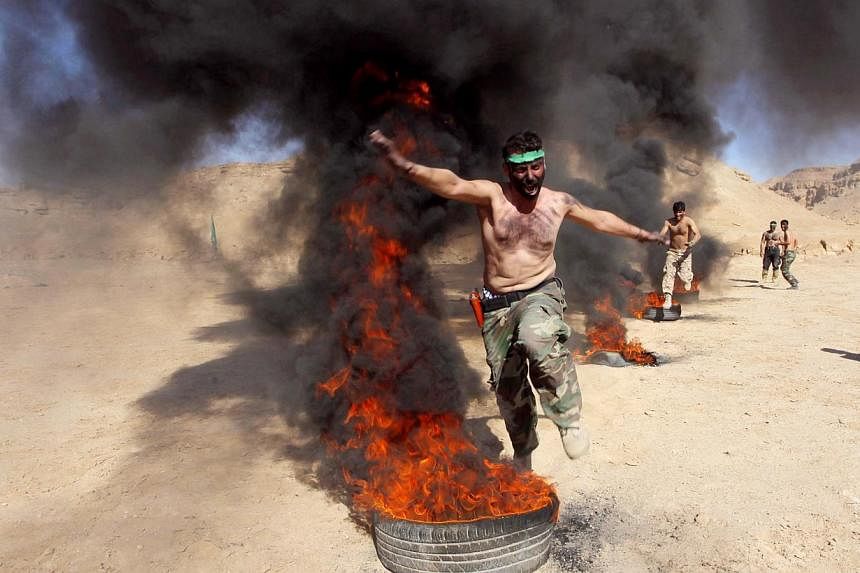PARIS (AFP) - The Islamic State in Iraq and Syria (ISIS) group has learned from the mistakes of past extremist movements and established a near-impregnable base of support within Iraq and Syria with spectacular appeal to many of the world's Sunni Muslims, a new book has warned.
The authors of ISIS: Inside The Army Of Terror, published this month in the US, spoke to dozens of fighters and members of the group to understand its allure and how it justifies its brutal tactics.
In a telephone interview with AFP, one of the authors, Syrian-born journalist Hassan Hassan, said it was vital to understand that some of the group's core religious beliefs were widely shared.
"It presents itself as an apocalyptic movement, talking about the end of days, the return of the caliphate and its eventual domination of the world," said Hassan, who lives in Abu Dhabi, where he works as a researcher for a think-tank.
"These beliefs are not on the margins - they are absolutely mainstream. They are preached by mosques across the world, particularly in the Middle East.
"ISIS takes these existing beliefs and makes them more appealing by offering a project that is happening right now," he said.
Hassan's research along with co-author Michael Weiss - a US-based journalist - gave them a rare insight into ISIS training camps for new recruits, which vary in length from two weeks to one year.
"Recruits receive military, political and religious training. They are also trained in counter-intelligence to avoid being infiltrated," said Hassan.
"After they graduate, recruits remain under scrutiny and can be expelled or punished if they show reservations, or sent back to the camps to 'strengthen their faith'."
ISIS uses certain texts and in-house clerics to provide religious justification for their violence, particularly a book called The Management Of Savagery, which argues that brutality is a useful tool for goading the West into an over-reaction.
SIX CATEGORIES
The authors outline six categories of ISIS recruit.
Only two are rooted in religion: the ultra-radicals who dominate the group's upper echelons, and recent converts to its extremist ideology.
Others are merely opportunists seeking money or power; pragmatists who want stability and see ISIS as the only game in town; and foreign fighters whose motives vary widely but "are almost always fed by serious misapprehensions of what is taking place in Iraq and Syria".
The final and most important category of recruit is often under-appreciated by the West - those drawn by the group's political ideology.
Many Sunni Muslims in the region feel threatened by Shias led by a resurgent Iran.
"Across the region, Shias are confident, bold and on the rise, while Sunnis feel insecure and persecuted," said Hassan.
"Many disagree with ISIS on ethical grounds but they see them as the only group capable of protecting them."
The authors also emphasise that ISIS is not new, but rather emerged from the ashes of Al-Qaeda in Iraq (AQI), one of the most brutal foes of the Americans following their 2003 invasion.
AQI was largely defeated after the US convinced local tribes to rise up against them - a strategy known as "the Awakening", which has deeply influenced ISIS strategy.
"From the beginning, they've been obsessed with the Awakening," said Hassan.
"They've done everything to prevent it happening again: built sleeper cells, bought loyalty, divided communities.
"They've succeeded in making internal resistance practically impossible. No tribe will fight them, because they will find themselves fighting their own brothers and cousins."
REVENGE OF SADDAM
The authors also depict ISIS as the revenge of Saddam Hussein's Baathist regime more than a decade after the late Iraqi dictator was thrown out of power.
Most of the top ISIS decision-makers served either in Saddam's military or security services, the book says.
Although the Baathists were originally a secular movement, Saddam introduced a "Faith campaign" in the 1990s that sought to Islamise society.
"Very few people have focused on the impact of that campaign," said Hassan.
"It radicalised many Baathists and they combined the violence of the regime with that of jihadism, making them even worse than Al-Qaeda."
Indeed, Osama bin Laden famously fell out with AQI leader Abu Musab al-Zarqawi over his horrific brutality and sectarian attacks on Shia Muslims.
Zarqawi, who was killed by a US missile strike in 2006, was so fanatical that he made bin Laden look like a moderate, and it is his mantle that has been picked up by ISIS.
Hassan remains pessimistic about Western counter-insurgency efforts.
"I keep hearing this argument that you can fight ISIS with propaganda, that this is an information war.
"But they have combined religion, geopolitics, economics and much more in their ideology. It's not a fragile ideology - it has mass appeal."

